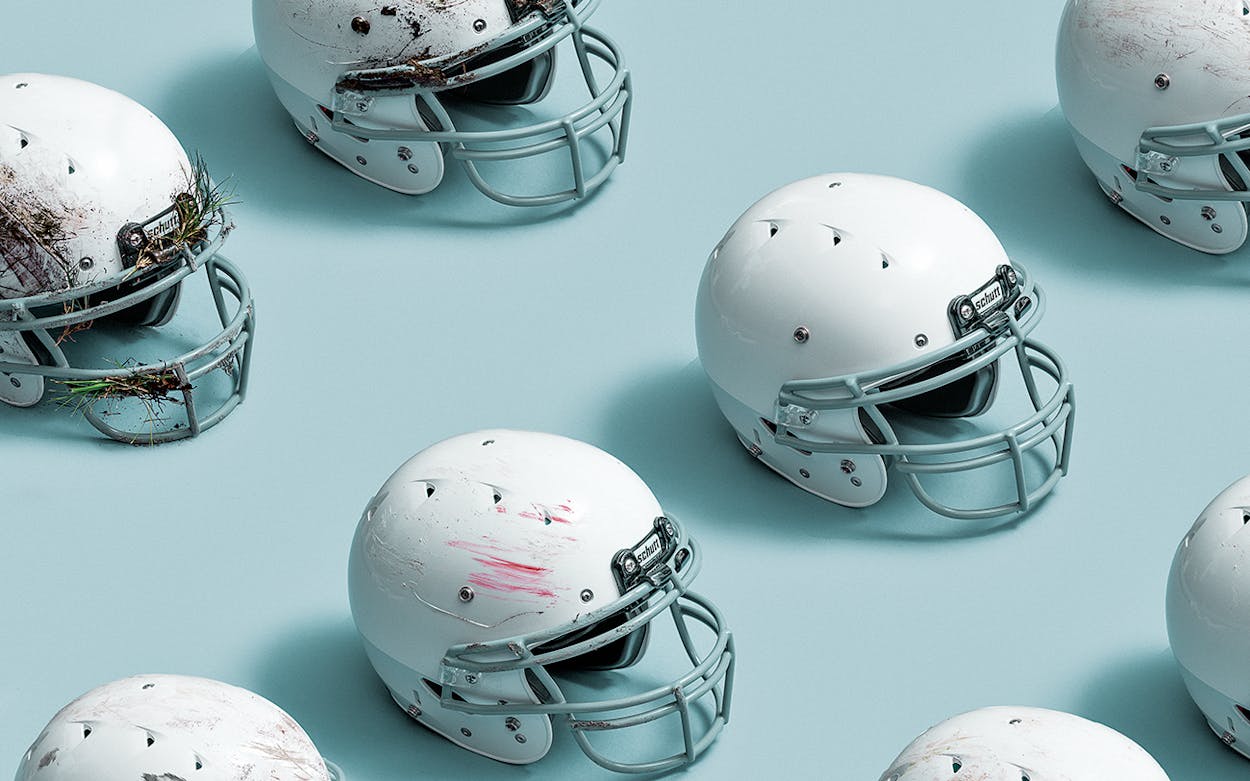This article originally appeared in the September 2017 issue of Texas Monthly with the headline “The Concussion Count.”
Munro Cullum likely has a hard time fitting his job title on his business cards: professor of psychiatry, neurology and neurotherapeutics, and neurological surgery at the Peter O’Donnell Jr. Brain Institute at UT Southwestern Medical Center. What the title lacks in brevity it makes up for in specificity by pointing to the man’s qualifications to tackle one of the toughest issues facing football and other sports today. In partnership with the University Interscholastic League (UIL), the organization that oversees public-school sports in Texas, Cullum is spearheading what’s expected to be the nation’s largest study of the prevalence of concussions among middle- and high-school student athletes. The statewide project has only just begun but aims to create a central registry of concussion cases that includes details such as players’ concussion histories, their gender, and the sport in which each injury happened. If it sounds relatively straightforward, think again. “It’s incredibly complex,” says the doctor. “And people have so many misconceptions and biases around the subject that it can be hard even to collect good data.” Cullum sat down with Texas Monthly to talk about how it’s going.
Tom Foster: Let’s start with the basics. What will you be able to learn from this study?
Munro Cullum: Speaking hypothetically, let’s say the Lewisville ISD buys all new football helmets. Well, what happens to their concussion rates? We can’t say until we have a baseline number to compare it to. It’s the same with rule changes to the game, or return-to-play or return-to-learn time lines, or informational campaigns.
TF: Maybe even more basic. Can you define a concussion?
MC: There are multiple definitions. A simple one is that a sudden jolt to the head shakes the brain in an abnormal fashion to the point that normal brain function is disrupted temporarily. The challenge is that the symptoms vary widely from individual to individual. And right now, we can’t predict who has which symptoms and for how long.
TF: So it’s hard to diagnose.
MC: Exactly. There’s no brain scan that can show a concussion. The way concussions are diagnosed is by a person asking another person a handful of questions. If the guy is staggering around or lying on his back with his arms out, a sixth grader can tell that he probably sustained a concussion, but usually it’s much more subtle. Do you have nausea, ringing in the ears, light sensitivity, noise sensitivity, dizziness, foggy thinking? Those are subjective symptoms, judged by different individuals with different backgrounds.
TF: Are there also challenges in just getting honest answers from players or coaches?
MC: Especially the athletes. They think, “If I tell Coach I need to sit out, then he’s going to start Joe, and what if Joe is better than I am and takes my position?”
TF: I can imagine the opposite too—a coach thinking, “The playoffs start next week, and I want to be sure I can play Joe Quarterback. Let’s keep him in the game.”
MC: That’s why we want more schools to have athletic trainers who are tasked with identifying concussions and pulling those students out. In the UIL study, we are not allowing the coaches to enter the data—so we can avoid bias.
TF: Is it even mandatory for schools to report concussions?
MC: Not yet, but the UIL’s intention is to make it mandatory. We had a company develop an app that the trainers can use to enter injuries, but we need to get the app in their hands, get districts to sign off, and so on. We need parental consent, and that brings up confidentiality questions [even though no individual information will be made public]. I’ve heard parents say, “Why would I want my child’s future sports agents to know how many concussions he’s had?”
TF: Wow. Do we at least know what kind of impacts to the head are the most dangerous?
MC: The living brain is squishy, like thick Jell-O, so it moves around in multiple directions depending where the impact occurs. It’s the rotational motion that seems to be the key in producing concussions; the rotation stretches and shears fibers in the brain’s white matter. That’s why in boxing, it’s the cross or the hook that’s most devastating. The football receiver being spun around from the blind side. It’s not as much the linear hits—although there is a whole other discussion about the effect of subconcussive hits.
TF: Speaking of that, are the many smaller hits players suffer actually a bigger problem? We’ve all seen the stories about deceased former football players’ brains.
MC: You’re talking about [the degenerative brain condition] CTE. Anecdotally, there are a lot of CTE cases among former NFL players, but that’s based on research on the brains of deceased former NFL players. It’s not a random or scientific sample. We do believe it’s a real condition, and the hypothesis is that it is a cumulative effect of multiple head traumas. But we do not know who is at most risk for it.
TF: So much of this debate centers on football. Is it actually the most dangerous sport?
MC: Among boys, it seems to be. Among girls, it’s soccer. But if you look at youth concussion rates, beyond just organized sports, do you know what activity causes the most concussions? Kids falling off their bikes. I never get calls from parents asking whether they should get their kid a bike. He’s older now, but I let my own kid play football. It just has to be played safely. We’re not trying to panic people or be detrimental to the sports; we just want to know what’s going on out there so we can make it more safe.









